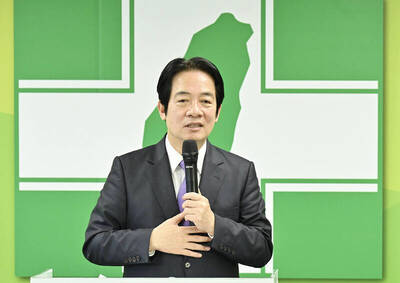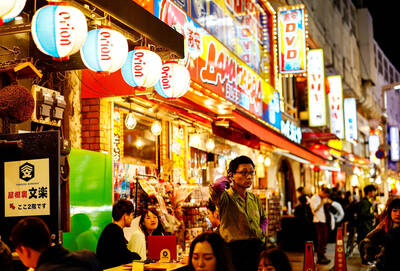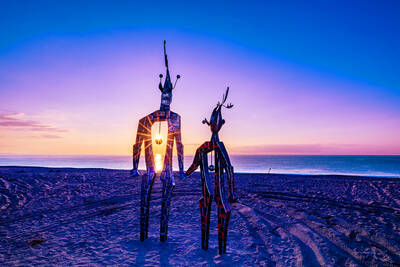Giant frogs in Toledo. Fiberglass horses in Lexington, Kentucky. Baseball bats in Cincinnati.
Public art displays that date to a 1998 fiberglass cow exhibit in Zurich, Switzerland, and Chicago's follow-up Cows on Parade in 1999 have been big business for cities. Organizers say they bring art to the public and showcase local talent. Critics argue that the increasingly popular exhibits degrade art.
Tom Eccles, director of the Public Art Fund in New York City, said he would prefer that cities support displays of contemporary art to expose the public to serious themes and fresh ideas.
"With the cows and the pigs and whatever comes next, I feel it's sort of a circus performance that has been done to promote town centers," said Eccles, whose organization sponsors art displays in Central Park, Rockefeller Center, Park Avenue and other New York sites. "On one level, they're harmless fun. On another level, they're kind of a dumbing-down of culture."
Cincinnati was host to the Big Pig Gig in 2000, when about 400 decorated fiberglass pigs were exhibited in the city and the neighboring northern Kentucky cities of Newport and Covington for nearly six months, harkening to Cincinnati's past as an 1800s hog slaughtering capital.
An economic study prepared for ArtWorks, the non-for-profit producer of the Pig Gig, estimated that the display helped to generate US$124 million in business sales, including spending by visitors.
Banking on the success of the Pig Gig, ArtWorks is sponsoring the Bats Incredible! project, which will be on view through mid-October. About 140 artists and about 40 school groups were commissioned to produce sculptures with 86cm baseball bats.
The bats theme recalls the city's history as home of the nation's first professional baseball team, the 1869 Cincinnati Red Stockings, now the Cincinnati Reds.
Such exhibits generally enlist artists for a fee, backed by sponsors that either keep the sculpture or donate it to be auctioned for charity.
"They're a gamble. They typically don't make money until the auction at the end," ArtWorks spokeswoman Betsy Neyer said.
Michael Lash, director of public art for the city of Chicago, said such exhibits bring art to those who might not go to museums. Chicago's 1999 cow exhibit was followed with street displays of furniture artworks titled Suite Home Chicago in 2001. The city is planning an Art in the Garden exhibit next year in which artists will be asked to design gardens.
"It desanctifies the whole idea of art in general," Lash said. "All of a sudden, you're in a relationship with an art object and nobody's telling you how to behave. There's no fee. Nobody's telling you to speak in hushed tones."
Chicago Commissioner of Cultural Affairs Lois Weisberg concedes the cows were not "great art."
"But they were out on the streets. People could see the colors," Weisberg said.
The Lexington Arts and Cultural Council in Kentucky continues to sell copies of a book it published as a guide for its 2000 display of decorated fiberglass horses on the streets of Lexington, long a center of the nation's horse racing industry.
Council president Jim Clark said the exhibit generated US$1.7 million, including US$700,000 distributed to arts and cultural organizations and US$370,000 for a trust fund to support public art. The horses were auctioned for an average price of US$10,000 and one sold for US$53,000, Clark said.
The Lexington arts council is now sponsoring Dynamic Doors: Portals to Creativity, a display of 128 decorated doors that were salvaged from the Bluegrass-Aspendale housing project built during the Depression and razed last year.
The displays seem to resonate with the public, especially if the themes are keyed to their cities' histories, Clark said.
"As you can imagine, the horse touches a chord here ... the horse being central to our economy in Lexington," he said. "It's a great way of getting a lot of people and community groups involved in the arts and public art, in particular."
Eccles said he believes the public would appreciate a higher level of artistic expression.
"I find the idea of cows and pigs decorated by artists kind of depressing," Eccles said. "If that's the best we can do with our artists today, we're in a sad place. But I don't think it is. I think the public is open to the idea of contemporary art."
Bob Lynch, president and chief executive officer of the Washington, DC-based Americans for the Arts, said art covers a wide spectrum, involving playful and serious.
"There's a place for both," he said.
On the Net:
Bats Incredible: http://www.batsincredible.com/
ArtWorks: http://www.mpistudio.com/bpg/artworks/artworks1.html
Lexington (Ky.) Arts Council: http://www.lexarts.org
Americans for the Arts: http://www.artsusa.org

May 11 to May 18 The original Taichung Railway Station was long thought to have been completely razed. Opening on May 15, 1905, the one-story wooden structure soon outgrew its purpose and was replaced in 1917 by a grandiose, Western-style station. During construction on the third-generation station in 2017, workers discovered the service pit for the original station’s locomotive depot. A year later, a small wooden building on site was determined by historians to be the first stationmaster’s office, built around 1908. With these findings, the Taichung Railway Station Cultural Park now boasts that it has

The latest Formosa poll released at the end of last month shows confidence in President William Lai (賴清德) plunged 8.1 percent, while satisfaction with the Lai administration fared worse with a drop of 8.5 percent. Those lacking confidence in Lai jumped by 6 percent and dissatisfaction in his administration spiked up 6.7 percent. Confidence in Lai is still strong at 48.6 percent, compared to 43 percent lacking confidence — but this is his worst result overall since he took office. For the first time, dissatisfaction with his administration surpassed satisfaction, 47.3 to 47.1 percent. Though statistically a tie, for most

Six weeks before I embarked on a research mission in Kyoto, I was sitting alone at a bar counter in Melbourne. Next to me, a woman was bragging loudly to a friend: She, too, was heading to Kyoto, I quickly discerned. Except her trip was in four months. And she’d just pulled an all-nighter booking restaurant reservations. As I snooped on the conversation, I broke out in a sweat, panicking because I’d yet to secure a single table. Then I remembered: Eating well in Japan is absolutely not something to lose sleep over. It’s true that the best-known institutions book up faster

In February of this year the Taipei Times reported on the visit of Lienchiang County Commissioner Wang Chung-ming (王忠銘) of the Chinese Nationalist Party (KMT) and a delegation to a lantern festival in Fuzhou’s Mawei District in Fujian Province. “Today, Mawei and Matsu jointly marked the lantern festival,” Wang was quoted as saying, adding that both sides “being of one people,” is a cause for joy. Wang was passing around a common claim of officials of the People’s Republic of China (PRC) and the PRC’s allies and supporters in Taiwan — KMT and the Taiwan People’s Party — and elsewhere: Taiwan and